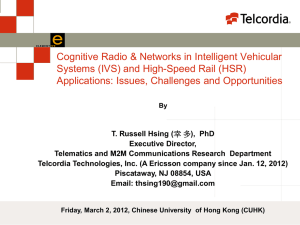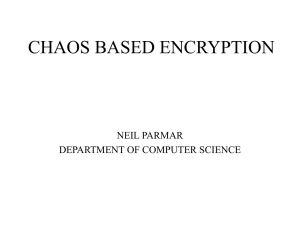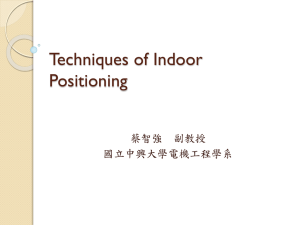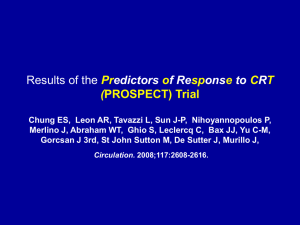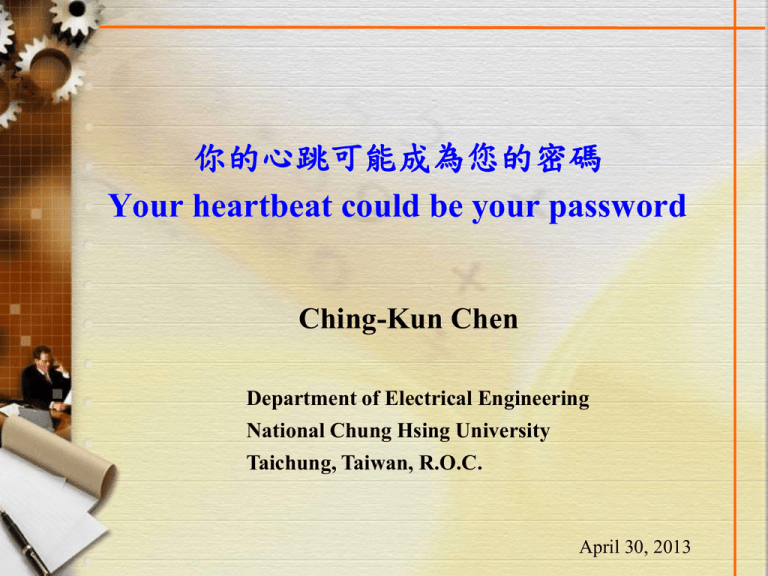
你的心跳可能成為您的密碼
Your heartbeat could be your password
Ching-Kun Chen
Department of Electrical Engineering
National Chung Hsing University
Taichung, Taiwan, R.O.C.
April 30, 2013
Outline
Introduction
Chaos and Quantifying Chaotic Behavior
Phase space reconstruction
Lyapunov Exponent
Chaotic Functions
ECG-Based Biometric Recognition
Synchronization of Two Identical Lorenz Systems
System Design and Secure Information Transmission
Experimental Results and Discussion
Conclusions and Feature Work
National Chung Hsing University
Department of Electrical Engineering
Bioinformatic Computing & Control Lab
Introduction
Motivation
As multimedia and network technologies continue to develop, digital
information is increasingly applied in real-world applications.
However, digitized information is easy to copy, making information
security increasingly crucial in the communication process.
Cryptography is one of basic methodologies for information security. Since
1990s, many researchers have noticed that there exists a close relationship
between chaos and cryptography. Recently, chaos theory gradually plays
an active role in cryptography consistently.
National Chung Hsing University
Department of Electrical Engineering
Bioinformatic Computing & Control Lab
Introduction
Motivation
Biometric based authentication system provides better security solutions
than conventional. But some biological parameters that are used as biometric
don’t provide the robustness against falsified credentials such as voice can
be copied through microphone, fingerprint can be collected on silicon
surface and iris can be copied on contact lenses. ECG doesn’t have these
problems and it’s unique in every individual.
Human heart is a supremely complex biological system. There are no model
that account for all of cardiac electrical activity. Researchers in the field of
chaotic dynamical system theory have used several features, including
correlation dimension (D2), Lyapunov exponents ( k), approximate entropy,
etc. These key features have can explain ECG’s behavior for diagnostic
purposes.
National Chung Hsing University
Department of Electrical Engineering
Bioinformatic Computing & Control Lab
Literature Survey
Chaos-related research
Chaos
Encryption
ECG
Transmission
National Chung Hsing University
Department of Electrical Engineering
Bioinformatic Computing & Control Lab
Literature Survey - Chaotic Encryption
Pareek et al. proposed an image encryption scheme which utilizes two
chaotic logistic maps and an external key of 80 bits. (2006)
Kwok et al. proposed a fast chaos-based image cryptosystem with the
architecture of a stream cipher. (2007)
Behina et al. proposed a novel algorithm for image encryption based on
mixture of chaotic maps, using one dimensional chaotic map and their
coupling to obtain high level security. (2008)
Zhu et al. proposed a chaos-based symmetric image encryption scheme
using a bit-level permutation. (2012)
National Chung Hsing University
Department of Electrical Engineering
Bioinformatic Computing & Control Lab
Literature Survey - Chaotic ECG Signal
Babloyantz et al. showed the human heart is not a simple oscillator, the
heart behavior exhibits a chaotic behavior. (1988)
Casaleggio et al. applied lyapunov exponents to analysis and estimation
of ECG signals from MIT-BIH database. (1995, 1997)
Owis et al. present a study of features based on the nonlinear dynamical
ECG signals for arrhythmia detection and classification. (2002)
Al-Fahoum et al. used simple reconstructed phase space approach for
ECG arrhythmia classification. (2006)
National Chung Hsing University
Department of Electrical Engineering
Bioinformatic Computing & Control Lab
Literature Survey - Chaotic Transmission
The application of chaotic synchronization to secret communication was
suggested by Pecora and Carroll. (1990, 1991)
A successful experimental realization of signal masking and recovery
was first made using electric circuits by Cuomo. (1993)
Control of chaos techniques have also been used for the transmission of
messages by means of chaotic signals. There are several control
techniques used to synchronize chaotic systems, such as fuzzy control,
delayed neural networks, impulsive control, and linear error feedback
control. The chaotic signals can be used to mask information waveforms
or serve as modulating waveforms.
National Chung Hsing University
Department of Electrical Engineering
Bioinformatic Computing & Control Lab
Chaos and Quantifying Chaotic Behavior
National Chung Hsing University
Department of Electrical Engineering
Bioinformatic Computing & Control Lab
Description of Methods
Phase space reconstruction
Packard et al. (1980)proposed phase space reconstruction that is a standard
procedure while analyzing chaotic systems which shows the trajectory
of the system in time.
Phase space in d dimensions display a number of points
where each point is given by
Z (n) z (n), z (n nT ),
, z (n (d 1)nT )
of the system,
Z (n)
(1)
where n is the moment in time of a system variable, nT T with denoting
the sampling period and T being the period between two consecutive
measurement for constructing the phase plot. The trajectory in d
dimensional space is a set of k consecutive points and where n 0 is the
starting time of observation.
National Chung Hsing University
Department of Electrical Engineering
Bioinformatic Computing & Control Lab
Description of Methods
Phase space reconstruction
Person1
2
2
1.8
1.8
1.6
1.6
z(n+nT)
Voltage(v)
Person1
1.4
1.2
1.4
1.2
1
1
0.8
0.8
0
0.5
1
1.5
time(sec)
2
Fig. 1 ECG Signals
2.5
3
0.5
1
1.5
2
z(n)
Fig. 2 Attractors of an ECG form encryption person
National Chung Hsing University
Department of Electrical Engineering
Bioinformatic Computing & Control Lab
Description of Methods
Correlation dimension - by Grassber & Procaccia (1983)
Reconstructed time series
X (t j ) {x(t j ), x(t j ), x(t j 2 )..., x(t j (m 1) )}
(2)
Calculating correlation integral
M
1
C ( ) 2 U ( xi x j )
M i , j 1,i j
(3)
where U is Heaviside step function, is the correlation length
0, x 0
U ( )
1, x 0
Correlation dimension D2 lim
0
ln C ( )
ln( )
(4)
National Chung Hsing University
Department of Electrical Engineering
Bioinformatic Computing & Control Lab
Description of Methods
Lyapunov Exponent
Lyapunov exponents are defined as the long time average exponential
rates of divergence of nearby states.
If a system has at least one positive Lyapunov exponent, than the system
is chaotic.
The larger the positive exponent, the more chaotic the system becomes.
In general Lyapunov exponents are arranged such that , where
1 and n correspond to the most rapidly expanding and contracting
principal axes, respectively. Therefore, may be regarded as an estimator
of the dominant chaotic behavior of a system.
1
2
n
1
e
2
t
e t
1
1
t t
i lim ln
i (t )
i (0)
National Chung Hsing University
Department of Electrical Engineering
Bioinformatic Computing & Control Lab
(5)
Description of Methods
Lyapunov Exponent
The largest Lyapunov exponent is treated as a measure of the ECG signal using
the wolf algorithm. The process of determination is listed as follows:
1. Compute the separation do of nearby two points in the reconstructed
phase space orbit.
2. Come next both points as they move
a short distance along the orbit.
.
Calculate the new separation d1.
3. If becomes do too large, keep one of the points and choose an
appropriate replacement for other point.
4. Repeat Steps 1-3 after propagations, the largest Lyapunov exponent
should be calculated via
1
1
t s t0
d1 (tk )
ln
d
(
t
)
k 1
0 k 1
s
(6)
where tk k
National Chung Hsing University
Department of Electrical Engineering
Bioinformatic Computing & Control Lab
Chaotic Functions
Chaotic Logisitic Map
The logistic map is a polynomial mapping of second order which chaotic
behavior for different parameters proposed by the biologist Robert May.
Ln1 ALn (1 Ln )
(7)
where n=0,1,2,…, 0 L 1 , 0 A 4
A is a (positive) bifurcation parameter.
.
1
1
0.9
0
0.8
-1
Lyapunov Exponent
0.7
0.6
0.5
0.4
0.3
-2
-3
-4
-5
0.2
-6
0.1
0
1
1.5
2
2.5
3
3.5
A
Fig 5. Bifurcation diagram for the logistic map
4
-7
1
1.5
2
2.5
3
3.5
4
A
Fig 6. Lyapunov exponents of the logistic map
National Chung Hsing University
Department of Electrical Engineering
Bioinformatic Computing & Control Lab
1
0.9
0.9
0.9
0.8
0.8
0.8
0.7
0.7
0.7
0.6
0.6
0.6
0.5
L
0.5
n
1
n
1
L
L
n
Property of logistic map with different bifurcation
parameter with L0=0.1
0.4
0.4
0.4
0.3
0.3
0.3
0.2
0.2
0.2
0.1
0.1
0.1
0
0
5
10
15
20
25
30
35
40
5
10
15
n
(a) A=2.7
0.8
0.7
n+1
0.6
L
0.4
0.3
0.2
0.1
0
0
30
35
0.1
0.2
0.3
0.4
0.5
Ln
0.6
0.7
0.8
0.9
1
0
40
5
10
15
20
25
n
n
(b) A=3.1
(c) A=3.8
1
1
0.9
0.9
0.8
0.8
0.7
0.7
0.6
0.6
0.5
L
0.5
25
n+1
0.9
20
30
35
40
0.5
L
1
n+1
0.5
0.4
0.4
0.3
0.3
0.2
0.2
0.1
0.1
0
0
0.1
0.2
0.3
0.4
0.5
Ln
0.6
0.7
0.8
0.9
1
0
0
0.1
0.2
0.3
0.4
0.5
0.6
0.7
0.8
Ln
National Chung Hsing University
Department of Electrical Engineering
Bioinformatic Computing & Control Lab
0.9
1
Chaotic Functions
Chaotic Henon Map
The Henon map is a 2-D iterated map with chaotic solutions
proposed by Mchel Henon (1976).
2
X n 1 1 aX n bYn
Yn 1 X n
where a and b are (positive)
bifurcation parameters
(8)
Henon Map
1.5
1.5
Y
.
1
1
0.5
0.5
0
0
-0.5
-0.5
-1
-1
-1.5
-1.5
-1
-0.5
0
X
0.5
1
1.5
Fig 3. Attractors for the Henon map with a=1.4;b=0.3
-1.5
0
0.2
0.4
0.6
0.8
1
1.2
1.4
Fig 4. Bifurcation diagram for the Henon map, b=0.3
National Chung Hsing University
Department of Electrical Engineering
Bioinformatic Computing & Control Lab
Chaotic Functions
The Lorenz system – by Edward Lorenz(1963)
20
x
x a( y x)
y bx y xz
z xy cz
0
-20
0
20
40
60
80
100
time
120
140
160
180
200
0
20
40
60
80
100
time
120
140
160
180
200
0
20
40
60
80
100
time
120
140
160
180
200
y
50
50
0
-50
40
100
z
30
z
20
50
10
0
40
0
20
20
10
0
0
-10
-20
y
-40
-20
-30
x
system parameters: a=10; b=28; c=8/3
Initial values: x0=-7.69; y0=-15.61; z0=90.39
National Chung Hsing University
Department of Electrical Engineering
Bioinformatic Computing & Control Lab
Characteristics of Chaotic Systems
They are aperiodic.
They exhibit sensitive dependence on initial conditions
and unpredictable in the long term.
They are governed by one or more control parameters,
a small change in which can cause the chaos to
appear or disappear.
Their governing equations are nonlinear.
National Chung Hsing University
Department of Electrical Engineering
Bioinformatic Computing & Control Lab
ECG-Based Biometric Recognition
National Chung Hsing University
Department of Electrical Engineering
Bioinformatic Computing & Control Lab
Normal 12-Lead ECG
ΦR
ΦR
ΦL
ΦR
ΦR
ΦL
ΦL
ΦL
LA
Lead I
VI = ΦL - ΦR
RA
ΦF
aVL
Lead II
VII = ΦF - ΦR
Lead III
VIII = ΦF - ΦL
ΦF
ΦF
aVR
aVF
Augmented-leads
ΦF
RF
LF
V1
V2
V3
Standard-leads
V4
V5
V6
Chest-leads
National Chung Hsing University
Department of Electrical Engineering
Bioinformatic Computing & Control Lab
ECG Waveform from electrical activities of heart
P wave
• Atrium
• Depolarization
QRS wave
• Ventricular
• Depolarization
T wave
• Repolarization
National Chung Hsing University
Department of Electrical Engineering
Bioinformatic Computing & Control Lab
A novel handheld device ET-600
Bio-potential
sensor
Bio-signal
measurement
ananlog
filter/amplifier unit
associative
processing unit
signal processing
unit
external input
device
display device
First active sensor
electorde
ESD
protection circuits
Buffer/balanced
circuit
Second active
sensor electorde
negative feedback difference
common mode signal
National Chung Hsing University
Department of Electrical Engineering
Bioinformatic Computing & Control Lab
ECG-Based Biometric Recognition
Comparison of related works with the proposed method
Method
Fiducial Detection
No. of Tested Su
bjects
Recognition
Rate*
Data Source
Electrode Orientation
Biel et al.[20]
PCA
Yes
20
95%
MIT-BIH
Standard Leads
(I,II,III)
Shen et al.[33]
Templ. Matching+D
BNN
Yes
20
95%
MIT-BIH
standard Lead I
Israel et al.[22]
LDA
Yes
29
90%
Collected from lab.
Standard 12-leads
Agrafioti et al[26].
LDA+PCA
No
56
95%
MIT-BIH/PTB
Standard Lead II
Wang et al.[25]
AC/DCT+KNN
No
13
95%
MIT-BIH/PTB
Standard 12-leads
Chan et al.[24]
Wavelet Distance
No
50
90%
Collected from lab.
standard Lead I
Khalil et al.[35]
High-order
Legendre
Polynomials
No
10
90%
Collected from lab.
standard Lead I
Fatemian et al.[38]
Wavelet+LDA
No
14
95%
MIT-BIH/PTB
Standard 12-leads
Chiu et al.[21]
Wavelet Distance
No
35
95%
MIT-BIH
standard Lead I
Loong et al.[36]
LPC+WPD
No
15
90%
Collected from lab.
standard Lead I
Coutinho et al.[39]
Cross Parsing+MDL
No
19
90%
Collected from lab.
standard Lead I
Silva et al.[37]
FSE
Yes
26
90%
Collected from lab.
Standard Lead I
Our research
[28-30]
Chaos Theory+
BPNN
No
19
90%
Collected from lab.
Lead I
(two contact points)
[*]value claimed in the paper
National Chung Hsing University
Department of Electrical Engineering
Bioinformatic Computing & Control Lab
Classification of ECG-Based Biometric Techniques
Direct Time-Domain Feature Extraction
Intervals (PQ, PR, QT intervals )
Durations (P, QRS, T durations)
Amplitudes (P, QRS, T amplitudes)
Slope (ST slope)
Segment (ST segment)
Frequency-Domain Feature Extraction
Wavelet Decomposition
Fourier Transform
Discrete Cosine Transform
Chaos Feature Extraction
Lyapunov Exponents
Correlation Dimension
National Chung Hsing University
Department of Electrical Engineering
Bioinformatic Computing & Control Lab
Age, height and weight of 19 subjects joining the experiment
Sub. A
Sub. B
Sub. C
Sub. D
Sub. E
Sub. F
Sub. G
Sub. H
Sub. I
Sex
Female
Male
Male
Male
Male
Male
Female
Female
Male
Age
(Yr)
25
27
25
24
31
24
22
17
53
Height
(cm)
153
172
175
173
170
166
152
158
173
Wight
(kg)
50
70
68
74
65
60
40
47
68
Sub. J
Sub. K
Sub. L
Sub. M
Sub. N
Sub. O
Sub. P
Sub. Q
Sub. R
Sub. S
Sex
Male
Male
Female
Male
Female
Male
Female
Female
Female
Male
Age
(Yr)
24
24
19
36
32
40
23
27
27
33
Height
(cm)
175
180
156
175
166
173
155
160
155
177
Wight
(kg)
71
75
46
69
53
72
49
50
45
77
National Chung Hsing University
Department of Electrical Engineering
Bioinformatic Computing & Control Lab
Distribution of the 19 subjects’ characteristics and their Centroids
-3
0
x 10
-0.02
-0.3
-0.32
-0.03
-2
2.8
2.6
2
-0.04
D
4
3
2
-0.34
-4
2.4
-0.36
-0.05
-6
-8
0.01
0.015
1
0.02
-0.06
0.01
0.025
2.2
-0.38
0.015
1
0.02
0.025
-0.4
0.01
0.015
1
0.02
2
0.01
0.025
0.015
1
0.02
0.025
-3
-0.32
-2
-0.025
-0.33
-3
-0.03
-0.34
3
2.8
-0.035
D2
-4
4
2.6
3
2
x 10
-0.02
-1
-0.35
2.4
-5
-0.04
-0.36
-6
-0.045
-0.37
-7
0.012
0.014
0.016
1
0.018
0.02
-0.05
0.012
0.014
0.016
1
0.018
0.02
-0.38
0.012
2.2
0.014
0.016
1
0.018
0.02
2
0.012
0.014
0.016
1
National Chung Hsing University
Department of Electrical Engineering
Bioinformatic Computing & Control Lab
0.018
0.02
1.3
-0.02
1.25
-0.03
-0.3
2.8
-0.32
2.6
1.15
1.1
0.01
-0.36
-0.05
0.015
1
0.02
-0.06
-8
0.025
1.3
2
-0.04
D
1.2
4
-0.34
3
V
rms
Distribution of the 19 subjects’ characteristics and their Centroids
2.2
-0.38
-6
-4
2
-2
-0.4
-8
0
-6
-3
x 10
-0.02
-0.32
-0.025
-0.33
-0.03
-0.34
2.4
-4
2
-2
2
-8
0
-3
-6
x 10
-4
2
-2
-4
2
-2
0
-3
x 10
3
2.8
1.25
-0.035
D2
4
3
Vrms
2.6
1.2
-0.35
2.4
-0.04
-0.36
-0.045
-0.37
1.15
1.1
0.012
0.014
0.016
1
0.018
0.02
-0.05
-8
-6
-4
2
-2
0
-3
x 10
-0.38
-8
2.2
-6
-4
2
-2
0
-3
x 10
2
-8
-6
National Chung Hsing University
Department of Electrical Engineering
Bioinformatic Computing & Control Lab
0
-3
x 10
Distribution of the 19 subjects’ characteristics and their Centroids
1.3
-0.3
2.6
1.25
-0.34
1.15
1.1
-8
-0.38
-6
-4
2
-2
-0.4
-0.06
0
2.2
-0.05
-3
x 10
1.3
2.4
1.2
V
-0.36
rms
D
1.2
2
4
rms
1.3
-0.32
1.25
V
2.8
-0.04
3
-0.03
-0.02
1.15
2
-0.06
-0.32
-0.05
-0.04
3
-0.03
1.1
-0.06
-0.02
3
-0.33
-0.04
3
-0.03
-0.02
1.3
2.8
1.25
-0.05
1.25
-0.34
Vrms
D2
4
Vrms
2.6
1.2
-0.35
1.2
2.4
-0.36
1.15
1.1
-8
-6
-4
2
-2
0
-3
x 10
-0.38
-0.05
1.15
2.2
-0.37
-0.04
3
-0.03
-0.02
2
-0.05
-0.04
3
-0.03
-0.02
1.1
-0.05
-0.04
3
-0.03
National Chung Hsing University
Department of Electrical Engineering
Bioinformatic Computing & Control Lab
-0.02
1.3
2.6
1.25
1.25
1.2
2.2
V
2.4
rms
1.3
rms
2.8
V
D
2
Distribution of the 19 subjects’ characteristics and their Centroids
1.15
1.15
2
-0.4
-0.35
4
1.1
-0.4
-0.3
3
2.8
1.2
-0.35
4
1.1
2
-0.3
1.3
1.3
1.25
1.25
2.2
2.4
D2
2.6
2.8
2.6
2.8
Vrms
D2
Vrms
2.6
1.2
1.2
2.4
2
-0.38
1.15
1.15
2.2
-0.36
4
-0.34
-0.32
1.1
-0.38
-0.36
4
-0.34
-0.32
1.1
2
2.2
2.4
D2
National Chung Hsing University
Department of Electrical Engineering
Bioinformatic Computing & Control Lab
Synchronization of two identical Lorenz systems
National Chung Hsing University
Department of Electrical Engineering
Bioinformatic Computing & Control Lab
Linear Coupled Feedback Synchronization Control
Driver system:
x1 10( y1 x1 ) d1 ( x2 x1 )
y1 28 x1 y1 x1 z1 d 2 ( y2 y1 )
8
z1 x1 y1 z1 d3 ( z2 z1 )
3
ex (t ) x1 (t ) x2 (t )
e y (t ) y1 (t ) y2 (t )
ez (t ) z1 (t ) z2 (t )
(9)
15
Response system:
ex
ey
10
(10)
state errors
x1 10( y2 x2 ) d1 ( x1 x2 )
y2 28 y1 y2 x2 z2 d 2 ( y1 y2 )
8
z2 x2 y2 z2 d3 ( z1 z2 )
3
(11)
ez
5
0
-5
where di>0(i=1,2,3) are coupling coefficients;
ei(t) are error states, ei(t) →0 (t →∞, i = x, y, z)
-10
0
0.5
1
1.5
2
2.5
time(sec)
National Chung Hsing University
Department of Electrical Engineering
Bioinformatic Computing & Control Lab
3
Chaotic phase trajectories for two Lorenz system
driver system
driver system
40
driver system
55
55
50
50
45
45
40
40
35
35
(10,25)
20
z1
y1
10
0
-10
z1
30
30
25
25
20
20
15
15
-20
(10,10)
10
-30
-20
-15
-10
-5
0
5
10
15
20
5
-20
25
30
-15
-10
-5
0
x1
5
10
15
(25,10)
10
20
5
-30
25
-20
-10
0
x1
response system
response system
30
10
20
30
40
y1
response system
50
50
45
45
40
40
35
35
30
30
(20,11)
z2
y2
10
0
-10
z2
20
25
25
20
20
15
15
-20
10
10
(20,5)
-30
-20
-15
-10
-5
0
5
x2
10
15
20
25
5
-20
-15
-10
-5
0
5
x2
10
15
20
25
5
-30
(11,5)
-20
-10
0
10
20
y2
National Chung Hsing University
Department of Electrical Engineering
Bioinformatic Computing & Control Lab
30
Simulations of Synchronization Control
of Lorenz System with ECG Signal
ECG signal
ECG-Mask
ECG-Org
30
2
2
1.8
1.8
20
1.6
1.6
1.2
1
voltage(v)
1.4
voltage(v)
voltage(v)
10
0
1.4
1.2
1
-10
0.8
0.8
-20
0.6
0.4
0.6
0
0.5
1
1.5
2
2.5
-30
3
0
0.5
1
time(sec)
1.5
2
2.5
3
0.4
0.5
1
30
1.8
10
3
0
5000
10000
15000
0
5000
10000
15000
0
5000
10000
15000
4
x2-y2
X(j+tau)
2.5
0
-2
1.6
1.2
2
2
20
1.4
1.5
time(sec)
x1-y1
2
0
2
0
-2
-10
1
2
x3-y3
X(j+tau)
0
time(sec)
-20
0.8
0.8
1
1.2
1.4
X(j)
1.6
1.8
2
-30
-30
-20
-10
0
10
20
30
0
-2
-4
X(j)
National Chung Hsing University
Department of Electrical Engineering
Bioinformatic Computing & Control Lab
Hardware Implementation of the Lorenz-based Oscillator
x a( y x)
y bx y xz
z xy cz
Component list of Lorenz-Based chaotic masking communication circuits
Element number
Description
Value
Tolerance
U1~U5
Op Amp (LF412)
R1,R4,R8~R18,R21,R23
1/4W Resistor
10 KΩ
±0.05%
R2,R19
1/4W Resistor
374 KΩ
±0.05%
R3,R20
1/4W Resistor
35.7 KΩ
±0.05%
R5,R22
1/4W Resistor
1 MΩ
±0.05%
R6,R7,R23,R24
1/4W Resistor
100 KΩ
±0.05%
C1~C6
Capacitor
0.1μF
±0.1%
M1~M4
Analog multiplier
National Chung Hsing University
Department of Electrical Engineering
Bioinformatic Computing & Control Lab
Lorenz-Based chaotic masking communication circuit
C1
C2
ECG Signal
C3
+12
R10
R2
R5
R7
R9
R11
U3
ECG_Masking
+12
+12
+12
+12
R1
R3
U1
y1
M1
M2
U1
R6
U2
R8
z1
R4
U2
-1 2
x1
-1 2
Driver System
-1 2
R13
-1 2
R12
-1 2
driver signal
C4
C5
C6
R19
R22
R24
Public Channel
R14
+12
+12
+12
+12
R18
R20
U4
y2
M3
M4
U4
R23
U5
R15
z2
R21
ECG Signal
x2
ECG_Masking
-1 2
-1 2
U5 .
-1 2
R16
R17
-1 2
Response System
National Chung Hsing University
Department of Electrical Engineering
Bioinformatic Computing & Control Lab
Hardware Implementation of the Lorenz-based Oscillator
25
50
50
20
45
45
40
40
35
35
30
30
15
10
0
z1
z1
y1
5
25
25
20
20
15
15
10
10
-5
-10
-15
-20
-25
-20
-15
-10
-5
0
5
x1
(a)x-y plane
10
15
20
5
-20
-15
-10
-5
0
5
10
15
20
5
-25
-20
x1
-15
-10
-5
0
5
10
15
20
y1
(b)x-z plane
Phase portraits of Lorenz oscillator
(c)y-z plane
National Chung Hsing University
Department of Electrical Engineering
Bioinformatic Computing & Control Lab
25
Synchronization of Lorenz-Based Circuits
25
20
15
10
x2
5
0
-5
-10
-15
-20
-20
-15
-10
-5
0
5
10
15
20
25
x1
(a) numerical plot
(b) experimentally obtained
The synchronization of the driver signal x1 and response signal x2
National Chung Hsing University
Department of Electrical Engineering
Bioinformatic Computing & Control Lab
voltage(v)
Synchronization of Lorenz-Based Circuits with ECG Signal
2
1
0
0
0.5
1
1.5
2
2.5
3
2
2.5
3
2
2.5
3
voltage(v)
time(sec)
50
0
-50
0
0.5
1
1.5
voltage(v)
time(sec)
2
1.5
1
0.5
0
0.5
1
1.5
time(sec)
(a) numerical plot
(b) experimentally obtained
Channel 1: private key ECG_signal,
Channel 2: transmitted chaotic signal ECG_masking,
Channel 3: recovered private key ECG_signal in the response system
National Chung Hsing University
Department of Electrical Engineering
Bioinformatic Computing & Control Lab
The testing scene of self-developed ECG acquisition system
with Lorenz-based circuits
National Chung Hsing University
Department of Electrical Engineering
Bioinformatic Computing & Control Lab
System Design and
Secure Information Transmission
National Chung Hsing University
Department of Electrical Engineering
Bioinformatic Computing & Control Lab
Concept of Cryptography
• Classical cryptography - Caesar displacement
Plaintext:THE QUICK BROWN FOX JUMPS OVER THE LAZY DOG
Ciphertext:WKH TXLFN EURZQ IRA MXPSV RYHU WKH ODCB GRJ
National Chung Hsing University
Department of Electrical Engineering
Bioinformatic Computing & Control Lab
Concept of Cryptography
• Modern cryptography
•
When K1=K2, the system is called symmetric encryption system.
•
When K1 K2, the system is called asymmetric encryption system, where K1 is called public key and
K2 is called secret key.
National Chung Hsing University
Department of Electrical Engineering
Bioinformatic Computing & Control Lab
Information encryption and decryption scheme
s
Plain Text
Plain Image
ECG-Org
2
1.8
voltage(v)
1.6
1.4
1.2
Initial
Key
1
0.8
0.6
0.4
Heart Pal
0.5
1
NI USB- 6211
1.5
2
2.5
3
time(sec)
Feature Extraction
Chaotic Function
( Logistic Map)
ECG-Mask
30
Self-made ECG
Acquisition System
ECG-Org
2
20
1.8
10
1.6
voltage(v)
voltage(v)
User
0
0
-10
-20
+
-30
1
1.5
2
2.5
3
-
time(sec)
Public Channel
Chaotic Function
( Henon Map)
Key Serial
Chaotic Function
( Henon Map)
Key Serial
Initial
Key
1
0.4
0
0.5
1
1.5
2
2.5
3
Cipher
Image
time(sec)
Feature Extraction
Chaotic Function
( Logistic Map)
Driver System
Image Encryption
1.4
0.6
0.5
Text Encryption
1.2
0.8
0
Key Serial
Key Serial
Image Decryption
Text Decryption
Response System
Lorenz-based chaotic
circuits
Encryption/Decryption
Algorithms
Plain Text
Plain Image
National Chung Hsing University
Department of Electrical Engineering
Bioinformatic Computing & Control Lab
Cipher text
Structure of the secure information transmission
Driver System
Response System
Lorenz-based chaotic circuits
+
Public Channel
ECG-Mask
-
30
20
voltage(v)
10
0
-10
-20
ECG-Org
-30
2
0.5
1
1.5
2
2.5
3
2
1.8
1.6
1.6
1.4
1.4
voltage(v)
voltage(v)
ECG-Org
0
time(sec)
1.8
1.2
1
Private Key
(encryption person’s ECG data)
0
0.5
1
1.5
2
2.5
1
0.8
0.6
0.4
1.2
Private Key
(encryption person’s ECG data)
0.8
0.6
0.4
3
time(sec)
0
0.5
1
1.5
2
2.5
3
time(sec)
Feature Extraction
Program
Feature Extraction
Program
Cipher
document
Plain
document
Chaotic Encryption
Program
Sender
Public Channel
Chaotic Decryption
Program
Plain
document
Recipient
National Chung Hsing University
Department of Electrical Engineering
Bioinformatic Computing & Control Lab
Experimental Results and Discussion
National Chung Hsing University
Department of Electrical Engineering
Bioinformatic Computing & Control Lab
Experimental Parameters
TABLE I
Computed 1 of ECG Signals for Different Persons
Person 1
Person 2
Person 3
0.0239
0.0243
0.0241
1
TABLE III
Parameters of chaotic function for Encryption and Decryption
Items
Value
Description
n
1500
number of iterations
1 ( X 0 , Y0 , L0 )
0.0239
initial value formed by
1 of the person 1
a
1.4
system parameter of Henon map
b
0.3
system parameter of Henon map
A
4
system parameter of logistic map
TABLE IV
Parameters of chaotic function for Decryption
TABLE II
Different Kinds of Images
Filename
Size
Color type
cameraman.tif
256 × 256
8 bits grayscale
kids.tif
318 × 400
8 bits indexed
peppers.png
512 × 384
24 bits RGB
Items
Value
Description
n
1500
number of iterations
1 ( X 0 , Y0 , L0 )
0.0243
initial value formed by
1 of the person 2
a
1.4
system parameter of Henon map
b
0.3
system parameter of Henon map
A
4
system parameter of logistic map
National Chung Hsing University
Department of Electrical Engineering
Bioinformatic Computing & Control Lab
Simulation Results -8 bits graysc
ale
(a)
(e)
(b)
1600
1400
1200
1000
800
600
400
200
0
0
50
100
150
200
250
(f)
(c)
(d)
1200
1000
800
600
400
200
0
0
50
100
150
200
250
Fig 5. Encryption and Decryption for case 1
(a) original image. (b) histograms of original image. (c) encrypted image.
(d) histograms of encrypted image. (e) wrong decrypted image.
(f) correct decrypted image.
National Chung Hsing University
Department of Electrical Engineering
Bioinformatic Computing & Control Lab
Simulation Results -
8 bits index
ed
(a)
(e)
(b)
3500
3000
2500
2000
1500
1000
500
0
0
50
100
150
200
250
(f)
(c)
(d)
3500
3000
2500
2000
1500
1000
500
0
0
50
100
150
200
250
Fig 6. Encryption and Decryption for case 2
(a) original image. (b) histograms of original image. (c) encrypted image.
(d) histograms of encrypted image. (e) wrong decrypted image.
National Chung Hsing University
(f) correct decrypted image.
Department of Electrical Engineering
Bioinformatic Computing & Control Lab
Simulation Results -
(b)
(c)
(a)
3000
2500
2500
2000
2000
2000
1500
1500
1500
1000
1000
1000
500
500
500
0
0
50
100
150
200
250
(i)
3500
3000
0
2500
0
0
50
100
150
200
250
0
50
100
(g)
(f)
(e)
(d)
3500
3000
24 bits GRB
150
200
250
(h)
(j)
5000
3500
3500
3000
3000
2500
2500
2500
2000
2000
2000
1500
1500
1000
1000
500
500
4500
4000
3500
3000
1500
1000
500
0
0
0
50
100
150
200
250
0
0
50
100
150
200
250
0
50
100
150
200
250
Fig 7. Encryption and Decryption for case 3
(a) original image. (b)(c)(d) The histograms of red, green and blue channels of
original image respectively. (e) The encrypted image. (f)(g)(h) The histograms
of red, green and blue channels of encrypted image respectively.
(i) wrong decrypted image. (j) correct decrypted image.
National Chung Hsing University
Department of Electrical Engineering
Bioinformatic Computing & Control Lab
Simulation Results -
Document Blended with Figures an
d Text
Fig 8. original document
Fig 9. Ciphertext of the original document
National Chung Hsing University
Department of Electrical Engineering
Bioinformatic Computing & Control Lab
Simulation Results -
Document Blended with Figure
s and Text
Fig 10. Wrong decrypted plaintext
Fig 11. Resulting correct decrypted plaintext
National Chung Hsing University
Department of Electrical Engineering
Bioinformatic Computing & Control Lab
Key Space Analysis
Comparison of features of DES, Triple-DES, IDEA, PCEA
EDS
Triple-DES
IDEA
PCEA
Key space (bits)
56
112 or 168
128
Depend on chaotic maps’
properties,
can be ideally infinity
No. of rounds
16
48
8
1
No. of sub-keys
16
48
54
5 (bifurcation parameters:
(A,a,b),
initial value (1 ),
no. of iterations (n))
Key generation
Shift permute
Shift permute
Shifting
Iteration of the
chaotic maps
Block size (bits)
64
64
64
-
Mathematical
Operation
XOR,
fixed S-boxes
XOR,
fixed S-boxes
XOR, Addition,
Multiplication
Addition,
Subtraction,
Multiplication
Existence of
attack
Broken: Brute
Force, 1998
No known
attack
No known
attack
No known attack
National Chung Hsing University
Department of Electrical Engineering
Bioinformatic Computing & Control Lab
Conclusions
This study has presented a theoretical and experimental study on chaos
synchronization and masking of data communication using electronic devices
described by the Lorenz equations, and showed that the private key created by
ECG signals can be recovered from a chaotic carrier using a response system
whose chaotic dynamics is synchronized with a driver system.
We investigate the use of ECG signal features from nonlinear dynamic
modeling for information encryption, and present a personalized encryption
scheme based on the individual-specific features of ECG as a personal key.
Experimental results have proved its feasibility and effectiveness.
Moreover, the encryption time shows its applicability in real-time applications
for image encryption and data transmission. The proposed system can thus be
used for personalized secure data storage and transmission.
Future Work
The chaotic features of ECG that the characteristic distributions appear the
proposed features would be appropriate for biometric identification. In the
current stage of this research, the recognition process was conducted off-line
and the effectiveness of the proposed methods was tested on the normal rest
subjects. Investigation of the on-line operation to demonstrate possibility of
the proposed verification systems in practical applications such as the tested
subjects are under stressed or after exercise should be further studied.
On the application side, our proposed biometric identification can be
applied to the access control system, such as electromagnetic induction cards,
locks, etc.
List of Publication
[J1] C. K. Chen, C. L. Lin, C. T. Chiang, and S. L. Lin, “Information encryption using
ECG signals with chaotic functions,” Information Sciences, vol. 193, pp. 125-140,
2012. (SCI, Impact Factor:3.291, Rank:6/116) (NSC-99- 2221-E- 005-066).
[J2] C. K. Chen, C. L. Lin, S. L. Lin, Y. M. Chiu, and C. T. Chiang, “A Chaotic Theoreti
cal Approach to ECG-Based Identity Recognition ,” IEEE Computational Intelligence M
agazine , 2013, (SCI) (NSC-99-2221-E-005-066), revised.
[J3] C. K. Chen, C. L. Lin, C. T. Chiang, and S. L. Lin, “Personalized Information Encr
yption Using ECG Signals with Chaotic Functions and Secure Transmissions via Synch
ronized Circuits,” IEEE Transactions on System, Man ,and Cybernetics, Part B, 2013,
(SCI) (NSC-99-2221-E-005-066), revised.
[C1] C. K. Chen, C. L. Lin, and Y. M. Chiu, “Data Encryption Using ECG Signals with
Chaotic Henon Map,” in Proc. of International Conference on Information Science and
Applications, pp. 1-5, Seoul, Korea, 2010.
[C2] C. K. Chen and C. L. Lin, “Text Encryption Using ECG signals with Chaotic Logis
tic Map,” in Proc. of IEEE International Conference on Industrial Technology, pp. 17411746, Taichung, Taiwan, 2010.
[C3] C. K. Chen, C. L. Lin, and Yen-Ming Chiu, “Individual Identification Based on Ch
aotic Electrocardiogram Signals,” in Proc. of IEEE International Conference on Industri
al Technology, pp. 1765-1770, Beijing, China, 2011.
[C4]Y. H. Hsu, C. L. Lin, C. K. Chen, C. T. Chiang, and W. T. Yang, “Health Care Platf
orm Based on Acquisition of ECG for HRV analysis,” in Proc. of International Conferen
ce on Industrial Informatics, Beijing, China, 2012.
National Chung Hsing University
Department of Electrical Engineering
Bioinformatic Computing & Control Lab
National Chung Hsing University
Department of Electrical Engineering
Bioinformatic Computing & Control Lab
Thanks for your attention




